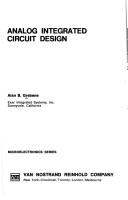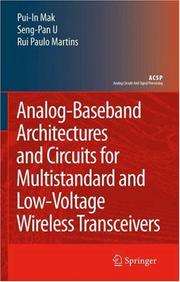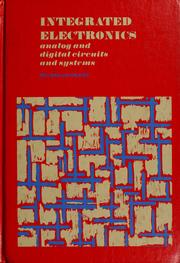| Listing 1 - 10 of 17 | << page >> |
Sort by
|
Book
Year: 1962 Publisher: Gaithersburg, MD : U.S. Dept. of Commerce, National Institute of Standards and Technology,
Abstract | Keywords | Export | Availability | Bookmark
 Loading...
Loading...Choose an application
- Reference Manager
- EndNote
- RefWorks (Direct export to RefWorks)
Book
Year: 1977 Publisher: Washington : United States Department of the Interior, Geological Survey,
Abstract | Keywords | Export | Availability | Bookmark
 Loading...
Loading...Choose an application
- Reference Manager
- EndNote
- RefWorks (Direct export to RefWorks)
Groundwater --- Analog computer simulation. --- Electromechanical analogies. --- Data processing. --- Arizona
Book
Year: 1952 Publisher: Washington, [D.C.] : National Advisory Committee for Aeronautics,
Abstract | Keywords | Export | Availability | Bookmark
 Loading...
Loading...Choose an application
- Reference Manager
- EndNote
- RefWorks (Direct export to RefWorks)
Book
Year: 1969 Publisher: [Lieu de publication non identifié] : [Éditeur non identifié],
Abstract | Keywords | Export | Availability | Bookmark
 Loading...
Loading...Choose an application
- Reference Manager
- EndNote
- RefWorks (Direct export to RefWorks)
Water-supply. --- Alimentation en eau --- Water --- Eau --- Analog computer simulation. --- Simulation par calculateur analogique --- Distribution. --- Distribution
Book
ISBN: 1608050378 9781608050376 9781461422952 1461422957 Year: 2012 Publisher: [Taiwan] : Bentham Science Publishers,
Abstract | Keywords | Export | Availability | Bookmark
 Loading...
Loading...Choose an application
- Reference Manager
- EndNote
- RefWorks (Direct export to RefWorks)
This e-book provides several state-of-the-art analog circuit design techniques. It presents both empirical and theoretical materials for system-on-a-chip (SOC) circuit design. Fundamental communication concepts are used to explain a variety of topics including data conversion (ADC, DAC, S-? oversampling data converters), clock data recovery, phase-locked loops for system timing synthesis, supply voltage regulation, power amplifier design, and mixer design. This is an excellent reference book for both circuit designers and researchers who are interested in the field of design of analog communic
Electronic analog computers --- Communication --- Network analysis (Communication) --- System analysis --- Analog computer circuits --- Electronic circuits --- Circuits. --- Network analysis. --- Methodology
Book
ISBN: 9781608050956 1608050955 9781608054251 Year: 2012 Publisher: [Saif Zone, Sharjah, UAE] : Bentham eBooks,
Abstract | Keywords | Export | Availability | Bookmark
 Loading...
Loading...Choose an application
- Reference Manager
- EndNote
- RefWorks (Direct export to RefWorks)
This e-book presents, details and exemplifies famous symbolic analysis techniques. Industrial R&D topics, recent developments and future trends in the field of symbolic analysis are also highlighted. This makes the e-book a good resource for circuit analysis. Thus, it is intended for students and researchers as well as for industry designers.

ISBN: 0442228279 Year: 1972 Publisher: Londres : Van Nostrand Reinhold,
Abstract | Keywords | Export | Availability | Bookmark
 Loading...
Loading...Choose an application
- Reference Manager
- EndNote
- RefWorks (Direct export to RefWorks)
Electronic analog computers --- Electronic circuit design --- Linear integrated circuits --- Linear ICs --- Analog integrated circuits --- Electronic circuits --- Analog computer circuits --- Circuits --- Design --- Électronique --- Électronique --- Integrated circuits

ISBN: 1281070130 9786611070137 1402064330 1402064322 9048176409 Year: 2007 Publisher: Dordrecht : Springer,
Abstract | Keywords | Export | Availability | Bookmark
 Loading...
Loading...Choose an application
- Reference Manager
- EndNote
- RefWorks (Direct export to RefWorks)
With the past few decade efforts on lithography and integrated-circuit (IC) technologies, very low-cost microsystems have been successfully developed for many different applications. The trend in wireless communications is toward creating a networkubiquitous era in the years to come. Many unprecedented opportunities and challenges, such as Design for multi-standardability and low-voltage (LV) compliance, are rapidly becoming the mainstream directions in wireless-IC research and development, given that the former can offer the best connectivity among different networks, while the latter can facilitate the technology migration into the sub-1-V nanoscale regimes for further cost and power reduction. Analog-Baseband Architecturees and Circuits presents architectural and circuit techniques for wireless transceivers to achieve multistandard and low-voltage compliance. The first part of the book reviews the physical layer specifications of modern wireless communication standards, presents the fundamental tradeoffs involved in transceiver architecture selection, and provides case studies of the state-of-the-art multistandard transceivers, where the key techniques reinforced are highlighted and discussed. A statistical summary (with 100+ references cited) of most used transmitter and receiver architectures for modern communication standards is provided. All the references are citied from the leading forums, i.e., ISSCC, CICC, VLSI and ESSCIRC, from 1997 to 2005. The second part focuses on the architectural design of multistandard transceivers. A coarse-RF fine-IF (two-step) channelselection technique is disclosed. It, through the reconfiguration of receiver and transmitter analog basebands, enables not only a relaxation of the RF frequency synthesizer’s and local oscillator’s design specifications, but also an efficient multistandard compliance by synthesizing the low-IF and zero-IF in the receiver; and the direct-up and two-step-up in the transmitter. The principle is demonstrated in few design examples. One of them is a system-in-a-package (SiP) receiver analog baseband for IEEE 802.11a/b/g WLAN. It not only has the two-step channel selection embedded, but also features a flexible-IF topology, a unique 3D-stack floorplan, and a particular design methodology for high testability and routability. The third part deals with the circuit design. In addition to the methodical description of many LV circuit techniques, 3 tailormade LV-robust functional blocks are presented. They include: 1) a double-quadrature-downconversion filter (DQDF) – it realizes concurrently clock-rate-defined IF reception, I/Q demodulation, IF channel selection and baseband filtering. 2) A switched-current-resistor (SCR) programmable-gain amplifier (PGA) – it offers a transient-free constant-bandwidth gain adjustment. 3) An inside-OpAmp dc-offset canceler – it saves the silicon area required for realizing a large time constant on chip while maximizing its highpass-pole switchability for fast dc-offset transient. The last part presents experimental results of the 3 tailor-made building blocks and a fully-integrated analog-baseband IC fabricated in a standard-VTH CMOS process. Previously untold on-/off-chip co-setup for both full-chip and building blocks measurements are described. Not only the building blocks have successfully extended the state-of-the-art boundary in terms of signal bandwidth and supply voltage, the analog-baseband IC has been so far the lowest-voltage-reported solution for IEEE 802.11a/b/g WLAN receivers.
Electronic analog computers --- Electronic circuit design. --- Mobile communication systems. --- Circuits. --- Vehicles --- Vehicular communication systems --- Radio --- Wireless communication systems --- Electronic circuits --- Analog computer circuits --- Communication systems --- Design --- Telecommunication. --- Systems engineering. --- Microwaves. --- Communications Engineering, Networks. --- Circuits and Systems. --- Microwaves, RF and Optical Engineering. --- Hertzian waves --- Electric waves --- Electromagnetic waves --- Geomagnetic micropulsations --- Radio waves --- Shortwave radio --- Engineering systems --- System engineering --- Engineering --- Industrial engineering --- System analysis --- Electric communication --- Mass communication --- Telecom --- Telecommunication industry --- Telecommunications --- Communication --- Information theory --- Telecommuting --- Design and construction --- Electrical engineering. --- Electronic circuits. --- Optical engineering. --- Mechanical engineering --- Electron-tube circuits --- Electric circuits --- Electron tubes --- Electronics --- Electric engineering
Book
ISBN: 9781402085734 1402085729 9781402085727 9048179157 1402085737 Year: 2008 Publisher: [Dordrecht] : Springer,
Abstract | Keywords | Export | Availability | Bookmark
 Loading...
Loading...Choose an application
- Reference Manager
- EndNote
- RefWorks (Direct export to RefWorks)
Structured Analog CMOS Design describes a structured analog design approach that makes it possible to simplify complex analog design problems and develop a design strategy that can be used for the design of large number of analog cells. It intentionally avoids treating the analog design as a mathematical problem, developing a design procedure based on the understanding of device physics and approximations that give insight into parameter interdependences. The proposed transistor-level design procedure is based on the EKV modeling approach and relies on the device inversion level as a fundamental design variable. Since all important design parameters can be expressed as continuous functions of the device inversion level, the design optimum as well as the technology limits can be easily found. The basic design concept consists in analog cell partitioning into the basic analog structures and sizing of these basic analog structures in a predefined procedural design sequence. The procedural design sequence ensures the correct propagation of design specifications, the verification of parameter limits and the local optimization loops. The proposed design procedure is also implemented as a CAD tool that follows this book. Finally, as a practical example, the design of analog amplifiers in a hybrid multi-bit Delta-Sigma modulator system is described in detail from system level to transistor level.
Engineering. --- Circuits and Systems. --- Processor Architectures. --- Computer science. --- Systems engineering. --- Ingénierie --- Informatique --- Ingénierie des systèmes --- Dielectrics. --- Electronic analog computers -- Circuits. --- Metal oxide semiconductors, Complementary. --- Metal oxide semiconductors. --- Electrical & Computer Engineering --- Engineering & Applied Sciences --- Electrical Engineering --- Electronic analog computers --- Circuits. --- Analog computer circuits --- CMOS (Electronics) --- Complementary metal oxide semiconductors --- Semiconductors, Complementary metal oxide --- Microprocessors. --- Electronics. --- Microelectronics. --- Electronic circuits. --- Electronics and Microelectronics, Instrumentation. --- Electronic circuits --- Digital electronics --- Logic circuits --- Transistor-transistor logic circuits --- Informatics --- Science --- Engineering systems --- System engineering --- Engineering --- Industrial engineering --- System analysis --- Electrical engineering --- Physical sciences --- Design and construction --- Minicomputers --- Electron-tube circuits --- Electric circuits --- Electron tubes --- Electronics --- Microminiature electronic equipment --- Microminiaturization (Electronics) --- Microtechnology --- Semiconductors --- Miniature electronic equipment

ISBN: 0070423156 9780070423152 Year: 1972 Publisher: New York McGraw-Hill Book Company
Abstract | Keywords | Export | Availability | Bookmark
 Loading...
Loading...Choose an application
- Reference Manager
- EndNote
- RefWorks (Direct export to RefWorks)
Integrated circuits --- Digital electronics --- Electronic analog computers --- Circuits --- 621.38 )* ELEKTRONICA --- elektronica --- transistoren --- Integrated circuits. --- -operationele versterker --- veldeffecttransistor --- digitale schakeling --- transistor --- diode --- analoge techniek (analoge elektronica) --- halfgeleider --- ic --- A/D-D/A converter --- Analog calculating-machines --- Computers, Electronic analog --- Analog computers --- Analog electronic systems --- Computers --- Hybrid computers --- Digital circuits --- Digital techniques (Electronics) --- Electronic systems --- Electronics --- Chips (Electronics) --- Circuits, Integrated --- Computer chips --- Microchips --- Electronic circuits --- Microelectronics --- opamp --- (zie ook: diode) --- (zie ook: DAC) --- Digital electronics. --- Circuits. --- Analog computers, Electronic --- operationele versterker --- Analog computer circuits --- Electronic analog computers - Circuits
| Listing 1 - 10 of 17 | << page >> |
Sort by
|

 Search
Search Feedback
Feedback About UniCat
About UniCat  Help
Help News
News